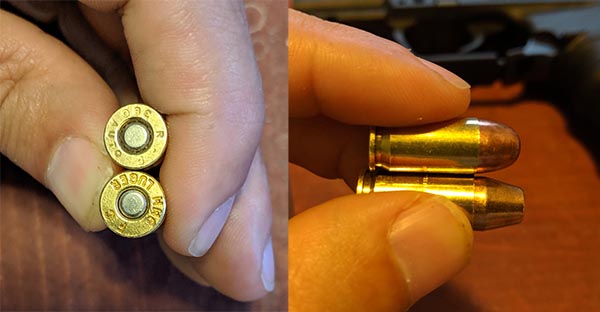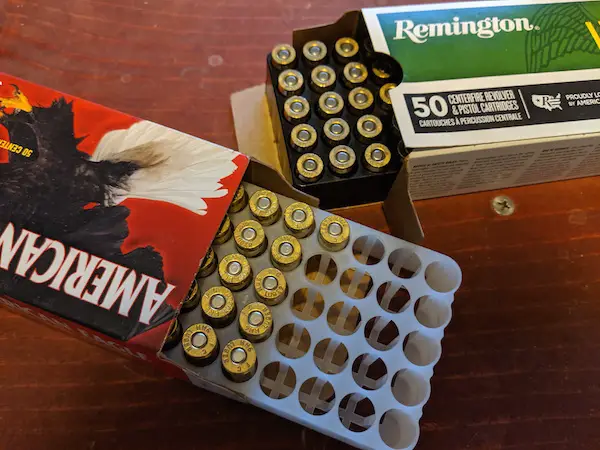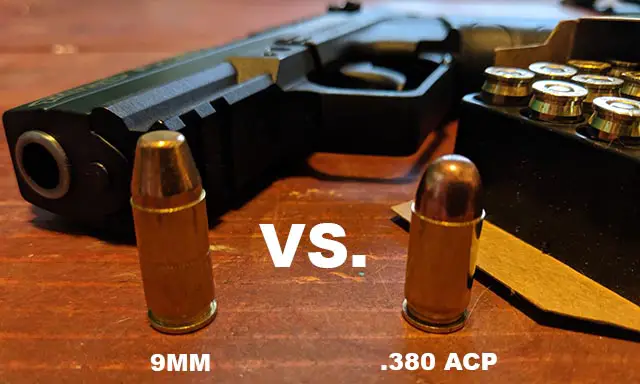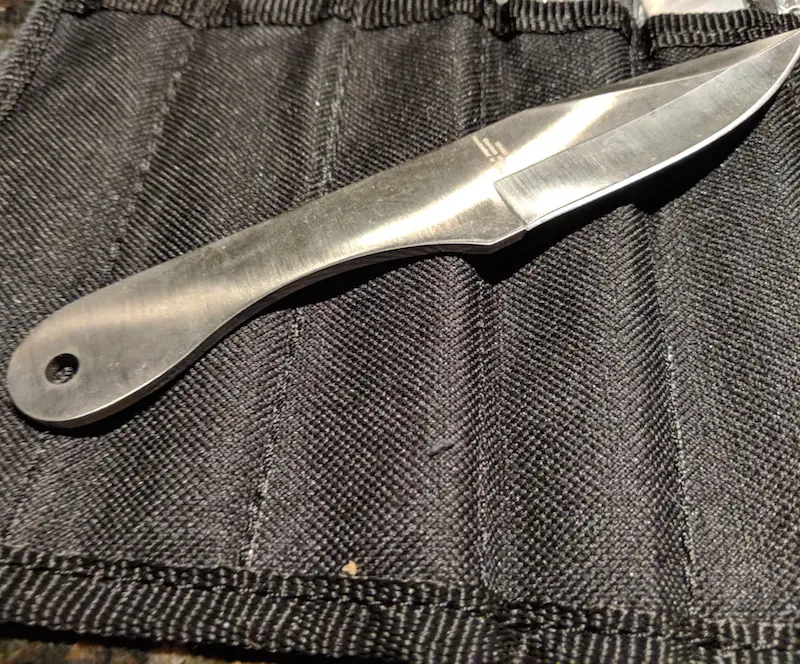Alright shooters, today we’re going to do a no BS comparison of the .380 ACP round to the classic 9mm round. The internet abounds with speculation about these two very similar cartridges, but is the 380 a good self defense round? Absolutely, the .380 ACP is a fine round for self defense and highly underrated. Commonly known as the 9mm short, this round has virtually the same bullet diameter as the traditional 9mm bullet. And, while the muzzle velocity is slower than the 9mm, the .380 round is more than capable of serving as a personal defense round and able to put down an attacker for good!
I was recently in the market for a new everyday carry pistol. Don’t get me wrong, I absolutely love my Sig Sauer. But I wanted something more compact, light-weight, and with a single stack magazine. I had a gift card to Cabela’s and wanted to update my concealed carry aresenal. Naturally, I began with what I knew. So after browsing the 9mm selection, and being less than thrilled with my low cost options, I decided to expand my horizons. Enter the Walther PPK.
The weapon was ergonomic, felt great in my grip, and most importantly it had a single stack magazine. But of course, it was chambered for .380 ACP instead of my go-to 9mm. I’ll admit I didn’t know much about this round. Therefore, I hit the internet (much like you) to find out the details on the 9mm short. Well folks, here’s what I found.
Table of Contents
Is A .380 The Same Size As A 9mm
First and foremost, I needed to know if this round was of similar size to the 9mm. Indeed, the .380 ACP, aptly named the 9mm short has a bullet diameter that is almost identical to the traditional 9mm (.355 inches). The main difference between the .380 ACP and 9mm Parabellum is the size of the casing, rather than the bullet. While the .380 ACP casing is .680 inches, the 9mm casing measures .754 inches.
If you’re looking for more detailed information about the cartridge sizes, feel free to check out the Wiki pages for the .380 ACP and 9mm Parabellum. However, my initial concerns that the Walther was going to be sending a smaller round downrange had been satisfied. At least I knew the size of the bullet was going to mirror what my current EDC pistol was shooting.
Of course, size doesn’t always matter. Because without the powder to back it up, I might as well throw the bullet at an attacker. So, I dug a little further into the ballistics of the 9mm vs the .380.
.380 ACP versus 9mm Ballistics
Having discovered that the bullet size of the .380 was comparable to the 9mm, I decided to investigate what impact the casing size had on performance. Because the casing of the 380 was smaller, I expected the grain count to be less. Therefore, I expected muzzle velocity to suffer. I was correct, but also pleasantly surprised.
For simplicity sake, I’m going to analyze standard ammunition for both types of rounds. What that means, is that I’ll be providing numbers for ball ammo, with whatever load is most commonly found in that caliber. With that being said, let’s get to the numbers.
9mm vs. .380 ACP Muzzle Velocity
Depending on the type of ammunition you load up, the muzzle velocity for 9mm was between 940 – 1280 according to ballistics 101. With such a wide range, I thought it best to take the median muzzle velocity. For FMJ ammo, the average velocity was just above 1066 feet per second.
According to balistics101, the .380 clocked in anywhere from 945 – 1085 feet per second from the muzzle for full metal jacket ammo. While the upper and lower range was not as disparate, for comparing the 380 to 9mm I felt it prudent to get the average velocity. Thus, the average for all the types of ammo sampled fell just shy of 964 feet per second.
With an average difference in velocity of approximately 100 feet per second between a .380 and 9mm round, the next question you’re likely to ask is “what does that mean in terms of performance?” Well, I’m glad you asked because I had the same question. In the future I’ll be adding a video of me firing ball ammo from my Sig and Walther to see what the penetration is for the .380 vs. the 9mm.

Different Types of Ammunition
If the numbers above are less than spectacular, and the video didn’t convince you that the .380 is an effective round, let’s take a look at other ammunition. All of the above measurements were for ball ammo. However, there are other ammunition options available for the .380 most notably “+P” ammunition.
What is +P ammunition?
You may see the designation “+P” on some boxes of ammunition, but what is +P ammunition? Using +P ammo means the pressure produced by the round exceeds that of a standard load. These types of over-pressure rounds produce higher muzzle velocities, when compared to their standard ammunition counterparts. Increased muzzle velocity means greater stopping power. Therefore, +P ammunition is better for self defense.
So, Why Not Use +P Ammo?
While the idea of +P ammunition seems enticing, the truth is, manufacturers may caution against the use of such rounds. Weapons are tested for quality and safety up to a certain threshold of pressure. Over-pressured ammunition can be dangerous when used in a firearm not rated for +P ammo. In fact, the manufacturers instruction manual for my Walther PPK cautions against using this type of ammo.
.380 vs 9mm Recoil Management
Now that we’ve covered the science (more or less) behind the .380 ACP and 9mm rounds, lets talk subjective traits. Whenever any size round is discussed, inevitably the discussion turns towards recoil. What the .380 lacks in muzzle velocity it more than makes up for in recoil management.
Recoil is determined by a number of factors, including shooter ability and handgun model. However, the size of the round plays a major role in the recoil experienced by a shooter. Also referred to as “kick” recoil is measured by the distance the muzzle is displaced after firing a round. The greater the recoil, the more difficult it is to achieve proper sight alignment and fire subsequent shots accurately.
Because there are many factors that influence the recoil a shooter will experience, it is hard to quantify this data. However, larger caliber rounds require more powder — measured in grains or weight — to produce adequate force to propel the bullet. While the 9mm and .380 are close in size, 9mm rounds typically have more powder in the cartridge. Therefore, firing a .380 produces less recoil than the 9mm.
Why Is .380 Ammo More Expensive?

Let’s get down to brass tax. See what I did there? What analysis would be complete without evaluating the impact of the round on your wallet (or purse)? The .380 ACP round is more expensive than a 9mm largely due to demand. Although the raw materials for creating the round indicate the .380 should be cheaper, mass production lowers the cost to manufacturers. Because the 9mm is one of the most widely used calibers, suppliers can pass any production savings onto consumers.
Of course, if your primary means of self defense is a pistol chambered in .380 there are ways to save money. I’d recommend checking out my article on ammo prices at gun shows for some money saving tips. However, .380 ammunition will cost roughly $1-$3 more for a box of 50 rounds. The difference in cost will vary and depends on the distributor, manufacturer, and round type (e.g. JHP, +P, etc.).
Can A .380 Stop An Attacker
A .380 round is more than capable of stopping an attacker. While the muzzle velocity isn’t equivalent to a 9mm round, the .380 is more than capable of penetrating soft tissue and putting down an assailant. Additionally, different types of self defense ammo, such as JHP (jacketed hollow point) and +P ammunition, make it clear that the firearm industry agrees.
Opponents of this position often cite the use of 9mm by law enforcement as a reason the .380 is inadequate round for self defense. Well lets examine this position. First, law enforcement are provided ammunition, and as I discussed earlier, 9mm rounds are cheaper. So providing hundreds of thousands of rounds can get pretty pricey. Second, many 9mm handguns come with magazines that can hold more rounds than a .380 PDW (personal defense weapon). Officers may be required to actively engage and/or pursue multiple assailants without backup, so having more bullets is necessary.
Additionally, if law enforcement encounters a suspect wearing a bullet proof vest (or high on drugs), the 9mm and .380 are equally obsolete. Therefore, making the argument that the 9mm long is better suited to stopping an attacker because it’s the round issued to officers does not hold water in my opinion.
Is A .380 Good For Concealed Carry?
We’ve talked about the rounds, now lets talk about the handguns. So, is the .380 good for concealed carry? Handguns chambered for .380 ACP are generally lighter, due to magazine capacity. Additionally, .380 caliber handguns are usually smaller, more concealable, with a slimmer profile. Finally, because the round is of similar size but with less recoil, it is a good choice for a personal defense weapon.

Although .380 pistols generally hold fewer rounds, typically these single stack magazines are more slender than their double stack counterparts. Fortunately, this makes concealing an extra magazine relatively easy with the proper magazine holster.
Parting Shots
Don’t let the name fool you, the 9mm short is a fantastic round, and more than adequate for self defense. The internet abounds with opinions on the .380 ACP’s effectiveness when compared to a 9mm. Hopefully the research above has given you a more accurate perspective. Do you have any qualms with the .380? Don’t agree that the .380 is a good self defense round? I’d love to read your comments for or against.










